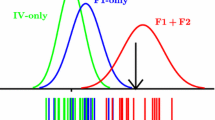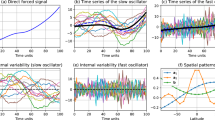Abstract
In the conventional approach to the detection of an anthropogenic or other externally forced climate change signal, optimal filters (fingerprints) are used to maximize the ratio of the observed climate change signal to the natural variability noise. If detection is successful, attribution of the observed climate change to the hypothesized forcing mechanism is carried out in a second step by comparing the observed and predicted climate change signals. In contrast, the Bayesian approach to detection and attribution makes no distinction between detection and attribution. The purpose of filtering in this case is to maximize the impact of the evidence, the observed climate change, on the prior probability that the hypothesis of an anthropogenic origin of the observed signal is true. Whereas in the conventional approach model uncertainties have no direct impact on the definition of the optimal detection fingerprint, in optimal Bayesian filtering they play a central role. The number of patterns retained is governed by the magnitude of the predicted signal relative to the model uncertainties, defined in a pattern space normalized by the natural climate variability. Although this results in some reduction of the original phase space, this is not the primary objective of Bayesian filtering, in contrast to the conventional approach, in which dimensional reduction is a necessary prerequisite for enhancing the signal-to-noise ratio. The Bayesian filtering method is illustrated for two anthropogenic forcing hypotheses: greenhouse gases alone, and a combination of greenhouse gases plus sulfate aerosols. The hypotheses are tested against 31-year trends for near-surface temperature, summer and winter diurnal temperature range, and precipitation. Between six and thirteen response patterns can be retained, as compared with the one or two response patterns normally used in the conventional approach. Strong evidence is found for the detection of an anthropogenic climate change in temperature, with some preference given to the combined forcing hypothesis. Detection of recent anthropogenic trends in diurnal temperature range and precipitation is not successful, but there remains strong net evidence for anthropogenic climate change if all data are considered jointly.


Similar content being viewed by others
Notes
see IPCC Data Distribution Centre, http://ipcc-ddc.cru.uea.ac.uk/ for further data, model descriptions and references
References
Allen MR, Tett SFB (1999) Checking for model consistency in optimal fingerprinting. Clim Dyn 15:419–434
Barnett TP (1999) Comparison of near-surface air temperature variability in 11 coupled global climate models. J Clim 12:511–518
Barnett TP, Hasselmann K, Chelliah M, Dellworth T, Hegerl GC, Jones PD, Rasmussen E, Roeckner E, Ropelewski C, Santer BD, Tett SFB (1999) Detection and attribution of recent climate change: a status report. Bull Am Meteorol Soc 80:2631–2660
Cubasch U, Santer BD, Hellbach A, Hegerl G, Höck H, Maier-Reimer E, Mikolajewicz U, Stössel A, Voss R (1994) Monte Carlo climate change forecasts with a global coupled ocean-atmosphere model. Clim Dyn 10:1–19
Dai A, Fung IY, Del Genio AD (1987) Surface observed global land precipitation variations during 1900-88. J Climate 10:2943–2962
Earman J (1992) Bayes or bust? A critical examination of Bayesian confirmation theory. MIT Press, Cambridge, Mass, USA
Easterling DR, Horton B, Jones PD, Peterson TC, Karl TR, Parker DE, Salinger MJ, Razuvayev V, Plummer N, Jamason P, Folland CK (1997) Maximum and minumum temperature trends for the globe. Science 277:364–367
Hasselmann K (1979) On the signal-to-noise problem in atmospheric response studies. In: Shaw DB (ed) Meteorology of tropical oceans. Royal Meteorological Society, London, pp 251–259
Hasselmann K (1997) Multi-pattern fingerprint method for detection and attribution of climate change. Clim Dyn 13:601–611
Hasselmann K (1998) Conventional and Bayesian approach to climate-change detection and attribution. Q J Meteorol Soc 124:2541–2565
Hegerl GC, von Storch H, Hasselmann K, Santer BD, Cubasch U, Jones PD (1996) Detection of greenhouse gas induced climate change with an optimal fingerprint method. J Climate 9:2281–2306
Hegerl GC, Hasselmann K, Cubasch U, Mitchell JFB, Röckner E, Voss R, Waszkewitz J (1997) On multi-fingerprint detection and attribution of greenhouse gas and aerosol forced climate change. Clim Dyn 13:613–634
Houghton JT, Meira Filho LG, Callendar BA, Harris N, Kattenberg A, Maskel K (eds) (1996) Climate change 1995: the science of climate change. Cambridge University Press, Cambridge, p 572
Houghton JT, Ding Y, Griggs DJ, Noguer M, van der Linden PJ, Dai X, Maskel K, Johnson CA (eds) (1996) Climate change 2001: the scientific basis. Cambridge University Press, Cambridge, p 881
IDAG (members involved in paper listed in footnote) (2004) Detecting and attributing external influences on the climate system: a review of recent advances. J. Climate (in press)
Jones PD, New M, Parker DE, Martin S, Rigor IG (1999) Surface air temperature and its changes over the past 150 years. Rev Geophys 37(2):173–199
Kass RE, Raftery AE (1994) Bayes factors. Technical Report 254, Department of Statistics, University of Washington, U S A, p 56
North GR, Kim KY, Shen SSP (1982) Sampling errors in the estimation of empirical orthogonal functions. Mon Weather Rev 110:699–706
Preisendorfer RW, Overland JE (1982) A significance test for principal components applied to a cyclone climatology. Mon Weather Rev 110:1–4
Risbey R Jr, Kandlikar M, Karoly DJ (2000) A protocol to articulate and quantify uncertainties in climate change detection and attribution. Clim Res 163:61–78
Santer BD, Wigley TM, Barnett TP, Anyamba E (1996) Detection of climate change and attribution of causes. In: Houghton JT et al (eds) Climate change 1995, the science of climate change. Cambridge University Press, Cambridge, pp 411–443
Smith RL, TML Wigley, Santer BD (2003) A bivariate time series approach to anthropogenic trend detection in hemispheric mean temperatures. J Clim 16:1228–1240
Stott PA, Tett SFB, Jones GS, Allen MR, Ingram WJ, Mitchell JFB (2001) Attribution of twentieth century climate change to natural and anthropogenic causes. Clim Dyn 15:1–22
Stouffer RJ, Hegerl G, Tett S (2000) A comparison of surface air temperature variability in three 1000-year coupled ocean-atmosphere model integrations. J Clim 13:513–537
Tett SFB, Stott PA, Allen MR, Ingram WJ, Mitchell JFB (1999) Causes of twentieth century temperature change near the Earth’s surface. Nature 399:569–572
Varis O, Kuikka S (1997) BeNe-EIA: a Bayesian approach to expert judgement elicitation with case studies on climate change impacts on surface waters. Clim Change 37:539–563
Acknowledgements
This work was supported by the National Oceanic and Atmospheric Administration (NOAA) Climate Change Data and Detection program and the US Department of Energy, Office of Energy Research, as part of the International ad hoc Detection Group effort, and by the European Commission QUARCC project, ENV4-96-0250.
Author information
Authors and Affiliations
Corresponding author
Rights and permissions
About this article
Cite this article
Schnur, R., Hasselmann, K. Optimal filtering for Bayesian detection and attribution of climate change. Clim Dyn 24, 45–55 (2005). https://doi.org/10.1007/s00382-004-0456-3
Received:
Accepted:
Published:
Issue Date:
DOI: https://doi.org/10.1007/s00382-004-0456-3




